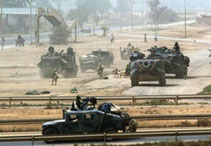|
Where
Has The Iraqi Army Gone?
 |
|
U.S.
tanks move freely in the heart of Baghdad
|
By
Abdul Raheem Ali, IOL Cairo Staff
CAIRO,
April 9 (IslamOnlin.net) - The disappearance of the Iraqi army in
Baghdad, no doubt, has become the troubling question now and the talk of
many people, who believe that the Iraqi army vanished into thin air.
“The
cakewalk entrance of the U.S. troops into the heart of Baghdad can be
explained in accordance with three key scenarios,” Mohammed Abdul
Salam, a military expert at Al-Ahram Centre for Political and Strategic
Studies (ACPS), told IslamOnline.net Wednesday, April 9.
The
military expert said that the massive U.S.-led air strikes on the
positions of the Republican Guard units around Baghdad were effective
and put an end to their resistance.
As
for the second scenario, he said, the Iraqi regime committed a blunder
when it divided the Republican Guard into small units, which led to
their disintegration.
‘A
Deal’
“The
third one has to do with a deal hammered out between the leaders of the
Republican Guard to lay down their arms without resistance,” he added.
Abdul
Salam further said the latest events in Baghdad came as a real surprise
to all military analysts.
He,
nevertheless, said that the U.S. control over Baghdad has marked the
collapse of the Iraqi government but not the regime, which is based on
large-scale section of the Iraqi population, military formations,
political groups and coherent tribes.
“To
my way of thinking, the new Iraqi regime would only be stabilized if it
was merged into the old guard. I believe that there is no other option
but to this one to form a new Iraqi regime,” he said.
“Add
to that, we can never talk about a stable Iraq without tackling first a
number of thorny issues such as the Sunni Arabs, cadres of Baath party,
tribes and clans close to Saddam and the Iraqi armed forces,” he
added.
Future
Holds Myriad Of Surprises
Abdul
Salam said that the few days ahead hold a lot of surprises, noting that
no one could predict the next moves precisely.
“Has
war come to an end? Would resistance pockets carry on with their
fighting? No body knows,” he said.
The
military expert also went for the claims that Saddam had taken shelter
in his northern home town of Tikrit.
“The
U.S. troops have already begun laying siege to Tikrit but I think the
U.S. will seek a political solution (to the crisis) since they do not
want to engage in more battles with the Iraqi fighters, hoping that it
would someday rebuild the Iraqi army,” he said.
Abdul
Salam also said that the situation in southern Iraq is far from being
stable yet, pointing out that the U.K. troops there wanted to stabilize
the region by appointing some chiefs of Iraqi tribes to run the southern
cities.
He
further said that the northern part of Iraq “derives its sensitivity
from the presence of the Kurdish fighters (peshmerga).”
“From
the very beginning, the U.S. troops did not intend to capture its
cities, including Kirkuk and Mosul, and that’s why they did not
intensify their air strikes there,” he added.
As
for the central part of Iraq, Abdul Salam said that the situation there
would rely on the U.S. future plans for post-war Iraq.
The
military expert said some locals have already taken control of a number
of Iraqi cities, asserting that they would target the members of the
ruling Baath part in these cities.
Earlier
in the day, U.S. tanks and troops poured into
the heart of Baghdad with Marines sending a towering bronze statue of
Saddam Hussein crashing to the ground amid loud cheers from a handful of
Iraqis on a central Baghdad square.
|